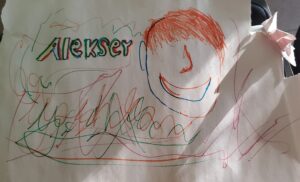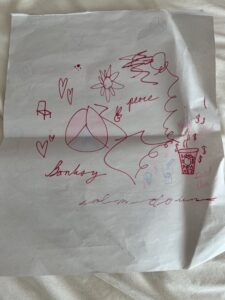Having Rich Stremme as a guest speaker during class on Friday was extremely interesting and eye-opening to the culture and world of punk rock in the 80s and 90s. The class learned about zines, a form of self-published magazine explicitly tailored for the punk community. Zines were filled with band reviews, art/graphics, lyrics, etc. His experiences marketing his band and putting himself out there through zines show how much society can change in a few decades. Personally, I found zines to be extremely interesting and unique to the era of punk rock he experienced. Zines show how accessible art truly is and how artists were able to specifically tailor their images to certain audiences, which with the internet today is virtually impossible to achieve. Additionally, I also found it interesting to see how the punk rock culture functioned during the era that was discussed. The pictures he presented to the class brought to light how predominantly male the punk rock fan base was in the Northeast. After learning about the “riot grrrl” movement, I have a greater appreciation for the boldness of women in punk rock after seeing the male-dominated field they inspired and broke through. Learning about his band, Process of Elimination, was equally fascinating. Hearing the funny anecdotes he shared was really unique to his experience in a punk rock band. One story that especially stuck out to me was his experience in El Paso, where he saw firsthand how widespread the punk rock movement truly was. In a predominantly Mexican area of Texas, he recalled performing his set while helicopters flew over with spotlights trying to spot immigrants cross the border. His anecdote of El Paso really stood out to me, because Stremme’s fans of his band came from all different races and backgrounds, representing the power music has to unite society. Hearing stories about punk rock culture directly from the source of someone who was in a punk rock band was exciting and sparked an interest in punk rock that I did not have before!
Posts
Punk Rock – Suzanna Grigoryan
Having a guest speaker talk about his experiences with punk rock was very unique and interesting, as it is not a field I normally hear about. Listening to Rich Stremme take us along his punk rock journey was very captivating. For him, his story started when his family moved to Connecticut and he was 11 years old. His aunt and uncle took him to a show and he found a group that sparked his interest, realizing that he wanted to be a part of their world. At the age of 12, he started making zines in order to start communication with people he did not know. Zines allowed him to network with people and create scenes with those in his area. His first show was to see the Anrthax and they later moved from the eastern part of Connecticut to the western part of the state for more space. He noticed that predominantly males attended these events, revealing the culture surrounding punk rock at the time. When he went to this show, he spread his zines around and met people that he ultimately wanted to begin a band with. Once he began making his own records, he sold them for a third less than what it cost him to produce, therefore he proved that the value for him was not in climbing an economic scale, but only socially become known. One of his most vibrant memories is the show he held in a poor neighborhood in Texas, nevertheless with people attending from both sides of the border. The events he experienced during this show felt surreal to him, as helicopters circulated with lights trying to catch border-hoppers. He channeled his experience in El Paso into the writing of his vinyl, Ashamed To Be White. After he graduated college, he moved to Brooklyn and met a graffiti artist, Revs. They initiated a collective band named God Squad and always had a mission; they would make crosses out wood and place them all over the city. Overall, punk rock is a free space, thus it does not need to be audio or physical, but whatever one can carve out and express, as Rich Stremme quotes from Ian MacKaye, concluding the essence of this topic.
Punk Seminar
Punk rock in the present-day is incredibly diverse due to its regionality and tendency to change with the political landscape, so I was curious what exactly we would be learning about the genre/culture during this seminar. I was somewhat involved in the punk community in my high school, but had just barely scratched the surface of what being punk meant.
Because of the subversive nature of punk, the word itself seems to come with a negative connotation in the mainstream. Many seem to associate punk with delinquency, but I view it as an exercise of free thought and expression, which is inherently anti-authority. Every person experiences punk in a different way depending on the demographics they fall under. For instance, the Mexican kids that Rich met in El Paso saw the punk community in West Texas as a place where they could be accepted.
Furthermore, I find that punk is more than just rock, it can be any form of expression, as long as that expression is anti-system. Graffiti and verbal protest are some very outstanding examples of this, but the ideals of punk apply to smaller actions such as the repurposing and repair of items, since not purchasing items new goes against the consumerism that is constantly being pushed onto us. This also goes to show how punk has evolved over time to address modern issues.
One thing that Rich mentioned that I found very interesting was that many of the few girls that got involved in the hardcore/punk scene during the 80s and 90s started off as photographers for shows, because that is exactly how I found myself going to shows in which my friends were performing. I also believe that the gender ratio at these shows has since shifted due to an increasing number of female artists in the scene.
Punk Rock seminar
I thought that learning about the punk rock scene in America was extremely fun and interesting. I love punk rock music and find it to be a great way for people to express themselves. At its core, it’s a form of rebellion against the system. Rich touched on this and shared how he was deeply inspired by the in-your-face style of punk rock music. It was fascinating to see how DIY the whole scene was—making your own advertisements, putting up your own signs, and even using graffiti to draw people in.
The most striking thing about it was how different the shows bands put on back then were compared to the ones today. Back then, it seemed to be much more chaotic, almost like a brawl, with very little security to prevent fights from breaking out. Nowadays, fights or other incidents at shows are much rarer. Additionally, the shows back then seemed far more communal, actively bringing people together.
All in all, I thought Rich’s presentation was extremely informative and interesting. Plus, I was able to snag some amazing free merch from it!
Class Graffiti


Class Graffiti

Class Grafitti

Graffiti

Class Graffiti

Suzanna Grigoryan – Graffiti/Street Art



